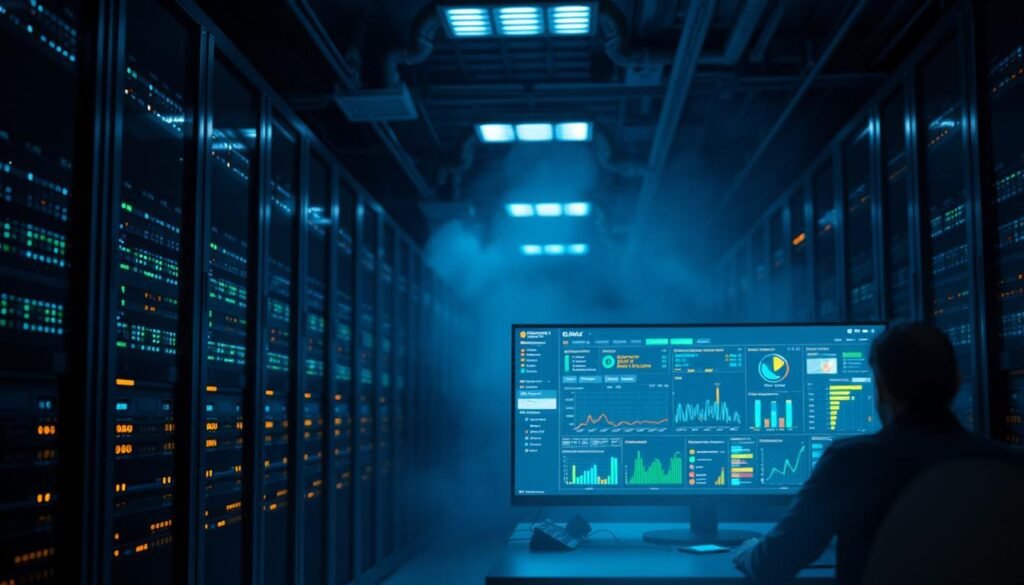Could a single platform really turn scattered logs into clear, actionable security intelligence? Modern organizations face fragmented visibility across cloud and network systems. A well-designed security platform unifies Security Event Management and Security Information Management to centralize security information and speed decisions.
This solution collects logs and data from endpoints, servers, applications, and cloud services. It correlates events, surfaces anomalies, and triggers alerts for fast threat detection and response. Teams get dashboards, real-time monitoring, and forensic tools that simplify investigations and compliance reporting.
Data ingestion happens via agents, API calls, network protocols, or direct access to log files. SOAR complements the platform by automating playbooks, enriching alerts, and orchestrating multi-tool response to contain incidents faster.
Key Takeaways
- Centralized logs drive earlier threat detection and consistent compliance reporting.
- Correlation and analysis reduce false positives and highlight signals that matter.
- Ingestion options match on-premises, cloud-native, and hybrid deployments.
- SOAR speeds incident response by automating repetitive tasks and enrichment.
- Machine learning helps baseline behavior and prioritize alerts for analysts.
SIEM
A consolidated security platform aggregates and correlates logs across servers, network devices, cloud apps, and firewalls to give teams one source of truth.
Definition: This solution ingests diverse telemetry and converts raw data into normalized events. Analysts see correlation-driven alerts, searchable logs, and dashboards that visualize active investigations and current risks.
In the Security Operations Center, the platform unifies information from disparate systems. That single pane improves monitoring and speeds decision-making during incidents.

Typical inputs include authentication logs, firewall events, endpoint activity, and cloud service records. Correlating these sources helps detect suspicious patterns in context, rather than isolated anomalies.
Daily benefits: Teams spend less time on manual searches and more on high-impact analysis. Consistent retention and standardized reporting simplify audit readiness and compliance across regulated environments.
| Capability | What it provides | Operational benefit |
|---|---|---|
| Log aggregation | Central store for logs from servers, firewalls, cloud | Faster search and forensic timelines |
| Correlation & alerting | Linked events and risk-based alerts | Reduced false positives, prioritized response |
| Dashboards & reporting | Visual risk summaries and compliance reports | Clear metrics for SOC and auditors |
| Scalability | Cloud-native options and tiered storage | Cost control as data volumes grow |
Next, we will look under the hood at how ingestion, normalization, correlation, alerting, and orchestration work together to detect and respond to threats.
How SIEM Works: From Log Collection to Detection and Response
Raw event feeds from apps, endpoints, and networks are transformed into prioritized incidents for response.
Data ingestion: logs, events, and telemetry
Ingestion pipelines collect data from endpoints, servers, network devices, cloud applications, and firewalls. Agents, APIs, native integrations, and direct log access feed continuous streams of events and telemetry.

Normalization, enrichment, and correlation
Normalization maps diverse formats to a common schema so queries and cross-source analysis work reliably.
Enrichment adds identity, asset, geo, and threat-intel context to make alerts actionable for analysts.
Correlation links simple rule matches to multi-signal analytics that group related events into a single incident.
Alerting, orchestration, and automated response workflows
Alerting uses thresholds, suppression, and deduplication to cut noise while keeping visibility on potential threats.
Orchestration hands prioritized cases to SOAR for containment, ticketing, and communication automation to speed detection response.
Deployment patterns: agents, APIs, and native integrations
On-prem, cloud-native, and hybrid solutions each affect scale, cost, and integration choices. Continuous tuning of rules, playbooks, and lists keeps detection aligned with attacker patterns.
| Stage | What happens | Operational benefit |
|---|---|---|
| Ingest | Agents, APIs, native connectors pull logs from systems and devices | Comprehensive coverage across cloud and network |
| Normalize & Enrich | Map to common schema; add identity and threat context | Faster, accurate analysis and prioritization |
| Correlate | Rule-based and multi-signal analytics join events into incidents | Higher-fidelity alerts and fewer false positives |
| Alert & Orchestrate | Thresholds, suppression, SOAR playbooks trigger response | Quicker containment and consistent incident handling |
Primary Capabilities of Modern SIEM Platforms
Modern platforms must gather and normalize telemetry from servers, endpoints, cloud services, and network devices into one searchable store.
Unified log management ingests and standardizes massive volumes of telemetry. Centralized retention, fast search, and long-term analysis make audits and trend studies practical. Data cleansing, transformation, and enrichment move raw feeds into a consistent schema for downstream use.

Cross-source correlation and anomaly detection
Correlation links events across users, endpoints, networks, and cloud workloads to reveal multi-stage attacks over time. Out-of-the-box correlation rules speed detection while allowing custom tuning for environment-specific threats.
Dashboards and security consoles
Live visualizations and a security event console show active incidents, trending threats, and surface risk priorities. Clear dashboards improve analyst productivity and support real-time monitoring.
Forensics, investigations, and reporting
Timeline reconstruction, artifact pivoting, and evidence export support internal reviews and regulatory audits. Audit-ready reports for PCI DSS, HIPAA, and GDPR can be scheduled or generated on demand.
“Centralized analysis of security data turns noise into prioritized actions.”
- Role-based access and multi-tenant views secure large teams.
- Alert routing and case integrations streamline response handoffs.
- Tiered storage and cloud elasticity control cost while scaling detection.
Real-Time Monitoring and Incident Response
Live monitoring ties user and device context to events so teams spot misuse fast.

Identity-aware monitoring for users, devices, and applications
Identity-enriched monitoring links users, devices, and applications to each event. This makes it easier to detect compromised accounts or unusual access patterns.
Corroborating identity with host and network telemetry raises alert fidelity. Analysts see who did what, where, and from which endpoint.
Correlation rules, predefined searches, and kill chain mapping
Effective platforms include libraries of customizable rules and out-of-the-box searches that detect known attacker behaviors quickly.
Mapping categorized events to a kill chain or MITRE ATT&CK framework helps teams understand adversary tactics and plan containment steps.
Reducing false positives and accelerating triage
Tune detections with thresholding, suppression, baselines, and dynamic risk scoring to prioritize actionable alerts.
In the event console, workflows should support enrichment, assignment, and evidence collection to speed incident response and reduce analyst toil.
“Context-rich alerts let teams focus on real threats, not noise.”
| Capability | What it does | Operational benefit |
|---|---|---|
| Identity enrichment | Links user and device context to events | Faster, precise detection of account misuse |
| Prebuilt rules | Out-of-the-box correlation searches | Quick detection of common attacker techniques |
| Kill chain mapping | Aligns events to attacker stages | Clear prioritization for containment |
| Triage workflows | Enrichment, assignment, evidence collection | Shorter mean time to respond |
User Monitoring, UEBA, and Threat Intelligence
Analyzing who accesses what, when, and from which device reveals stealthy misuse early.
User and entity behavior analytics (UEBA) baseline normal activity for accounts and devices. When a user logs in from an unusual location or at odd hours, the system flags that deviation for review.
Privileged user oversight enforces least privilege and supports regulatory needs. Monitoring admin actions helps reduce insider risk and provides audit trails for compliance such as SOX and HIPAA.
Integrating threat feeds and identity data
Curated threat intelligence enriches alerts by matching indicators to known campaigns and zero-day exploits. Correlating this information with identity, endpoint, and network signals surfaces lateral movement and privilege escalation.
- Risk scoring: Alerts include recent activity, user risk score, and asset criticality to help analysts prioritize.
- Feedback loops: Investigation outcomes refine behavior models and cut noise over time.
- Data quality: Consistent identity resolution across sources prevents blind spots and improves detection.
| Capability | What it uses | Benefit |
|---|---|---|
| UEBA baselining | Login times, access patterns, device telemetry | Flags anomalous activity quickly |
| Privileged monitoring | Admin sessions, privilege changes, audit logs | Meets compliance and reduces insider risk |
| Threat feed integration | Curated indicators, campaign signatures | Improves detection of advanced threats |
Risk-Based Alerting to Cut Noise and Focus on True Threats
Risk-based alerting groups related events into priority incidents so analysts see what matters first. This approach tags observations with context and scores, then raises issues only when the combined evidence meets a threshold.
Risk attribution and dynamic scoring
Risk attribution adds metadata like technique mapping, alert source, and asset criticality to each record. Tagging helps turn raw data into clear incident context.
Dynamic scoring increases urgency if a privileged account, sensitive data store, or internet-exposed server is involved. Scores update as new signals arrive, raising or lowering risk in real time.
Triggering alerts only with sufficient correlated evidence
Evidence thresholds require multiple corroborating signals before creating an incident. That prevents chatter from becoming noise and focuses analysts on real problems.
- Consolidates related detections into higher-fidelity incidents using cumulative scoring.
- Uses metadata tags—source, technique, asset—to build accurate context for investigations.
- Applies thresholds so only multi-signal events generate actionable alerts, reducing false positives.
- Integrates with SOAR to automate high-risk playbooks for containment and rapid response.
Governance of rules and score tuning aligns alerts with business risk tolerance. Incident consolidation speeds investigations and lowers analyst fatigue, improving detection and response across security systems and solutions.
Advanced Analytics and Machine Learning in SIEM
Behavioral models learn everyday activity so rare, risky deviations jump out to analysts. Modern machine learning brings layered analysis to security data. It finds subtle patterns that rule-based checks miss and speeds meaningful detection.
Behavioral baselining and anomaly detection
Behavioral baselining
Models learn normal user, host, and application activity. When an account or endpoint drifts from that baseline, the system flags the deviation as suspicious.
That approach catches lateral movement and stealthy intrusions that signature lists often miss.
Predictive insights and pattern discovery
Unsupervised and supervised models sift diverse telemetry to surface outliers and known malicious patterns. Correlating weak signals across data sources predicts how an attack might progress.
These insights help prioritize which incident to investigate first and which systems to isolate.
Lowering alert fatigue with ML-driven precision
Automated actions—quarantine, block traffic, or force reauthentication—can follow high-confidence detections to reduce dwell time.
Continuous model training and analyst feedback cut false positives and raise precision. Transparent feature attribution and explainability build trust.
“Advanced analytics turn noisy logs into prioritized, actionable signals for faster response.”
- Operationalize: Integrate ML outputs with SOAR and case tools to automate workflows.
- Data engineering: Maintain feature pipelines and quality checks so models stay accurate and cost-effective.
Benefits of Implementing SIEM for Security Operations
A unified event repository turns scattered telemetry into one operational picture for faster decisions.
Centralized visibility consolidates security data from endpoints, servers, applications, and cloud services. Teams gain a single vantage point that removes blind spots across network and hybrid systems.
Advanced correlation and analytics speed threat detection and compress time to response. Enriched alerts combine context from identity, asset, and threat feeds so analysts act on high-fidelity incidents.
- Aggregate logs and normalize events for consistent monitoring and audit trails that support compliance with PCI DSS, NIST, CIS, HIPAA, and GDPR.
- Layered detection—signatures, behavior analytics, and threat intelligence—improves accuracy across diverse attack types.
- Machine learning reduces noise, prioritizes critical alerts, and frees analysts for proactive threat hunting.
- Integrated playbooks and case workflows unite teams and shorten incident-to-containment timelines.
“Centralized security information and automated response deliver measurable ROI: fewer breaches, faster detection, and smoother audits.”
Limitations and Challenges in SIEM Deployment
Deploying a centralized event platform often hits a wall when diverse systems speak different data languages.
Integration complexity is common. Connectors must handle varied log formats, legacy platforms, and cloud-native services. Missing fields, timestamp drift, and duplicate events degrade correlation and make data less useful.
Many teams struggle with tuning. Building and testing rules and models takes ongoing engineering time. Without regular updates, alerts grow noisy and reduce analyst efficiency.
Cost and performance trade-offs matter. Ingestion volume, storage tiers, and compute for analytics drive bills. Bursty telemetry and long retention create scalability choices that affect latency and management overhead.
Operational limits include excessive false positives and visibility gaps. Without strong endpoint and identity integrations, critical activity can be missed across sources.
- Acknowledge onboarding hurdles: inconsistent schemas and legacy systems complicate setup.
- Improve data quality: normalize timestamps, dedupe events, and validate required fields.
- Plan costs: forecast ingestion, storage, and staff time for ongoing content management.
- Mitigate risk: phased rollouts, reference architectures, and proof-of-value pilots reduce disruption.
Practical approach: start small, prioritize high-value data, and iterate on rules and enrichment. This reduces upfront risk and keeps security teams focused on meaningful analysis and response.
Best Practices for SIEM Implementation and Tuning
Begin with a focused set of detection scenarios that align to business priorities and measurable goals.
Define use cases, scope, and success metrics. Start by mapping the top threats and the specific log sources required. Set clear KPIs such as mean time to detect and mean time to respond. Plan capacity for growth and pick a deployment model—cloud, on-prem, or hybrid—that meets scale and compliance needs.
Normalize data and design correlation rules. Build parsing standards so different sources feed consistent fields. Create rules aligned to ATT&CK techniques and apply allowlists, denylists, and thresholds to cut noise. Enrich events with identity and asset context to raise detection fidelity.
Automate, tune, and govern content. Use playbooks to automate containment, enrichment, notifications, and ticketing. Continuously tune rules and alerts based on incident reviews and threat intelligence. Establish governance for rule changes, documentation, and performance management.
Train teams and test workflows. Train analysts on investigation steps, query languages, and triage. Run tabletop and red-team exercises to validate incident response and monitoring workflows.
“Start small, measure results, and iterate—this keeps detections relevant while reducing alert fatigue.”
| Focus Area | Action | Benefit |
|---|---|---|
| Use cases & metrics | Map risks to required log sources and KPIs | Faster value and measurable security improvements |
| Data management | Normalize, enrich, and standardize parsing | Reliable correlation and accurate alerts |
| Automation | SOAR playbooks for routine tasks | Reduced manual toil and quicker response |
| Training & testing | Analyst training, tabletop and red-team tests | Improved incident handling and preparedness |
How SIEM Integrates with SOC, SOAR, and EDR
A modern security stack ties centralized event lakes to human analysts so teams see threats faster.
SIEM as the data and detection backbone
SIEM provides the SOC with aggregated, correlated data and real-time alerts that prioritize work for analysts.
It ingests logs from network devices, servers, and endpoint systems and turns noisy events into actionable information.
SOAR for orchestration and response at scale
SOAR operationalizes detections by running multi-step playbooks across ticketing, identity, network, and endpoint tools.
Playbooks automate containment, enrichment, and notifications so incident response moves faster and consistently.
EDR telemetry to enrich endpoint-centric detections
EDR feeds process, file, and memory telemetry into the same store and offers isolation capabilities for quick containment.
Bidirectional integration means the platform sends cases to SOAR and EDR, while endpoint artifacts and actions feed back to improve detections.
- Shared cases, timelines, and notes improve collaboration across security operations teams.
- Governance, role-based access, and change control keep integrations secure and auditable.
- Tight coupling reduces triage time, cuts missed threats, and shortens time from alert to remediation.
“Integrated systems turn separate tool outputs into coordinated incident response and measurable operational gains.”
SIEM vs CSPM: Different Goals, Complementary Coverage
A cloud posture tool scans resource settings and identifies insecure defaults before attackers exploit them.
Detective vs posture roles: A security information event platform detects and responds to incidents across networks, endpoints, and hybrid cloud by collecting and correlating security data. In contrast, cloud security posture management continuously inspects resources for misconfigurations, enforces policies, and offers remediation guidance.
CSPM flags risky settings and maps them to compliance controls. This reduces the surface that attackers can use. The detective platform focuses on live detection and response when potential threats appear.
Integrating CSPM findings into the detection stream helps correlate weak configurations with active indicators of compromise. For example, a CSPM alert for an exposed storage bucket plus unusual access logs in the event store should escalate priority and trigger an automated playbook.
Evaluation tips: Choose combined solutions that support multi-cloud systems, scale with data volume, and offer unified reporting and audit trails for compliance. Together, posture hardening and real-time detection deliver stronger, faster security outcomes.
Evaluating SIEM Solutions: Features, Platforms, and Cloud Readiness
Prioritize cloud-native designs that let you expand capacity on demand while controlling costs.
Start with architecture and cost. Favor siem platforms that offer elastic scaling, tiered storage, and transparent ingestion pricing. Validate retention tiers and query performance against your expected data volumes.
Usability, search, and investigation
Check dashboards, pivot-friendly searches, and case workflows. Fast, intuitive consoles reduce analyst friction and speed incident analysis.
Integrations, compliance, and ecosystem
Confirm connectors across identity, endpoint, network, email, SaaS, DevOps, and cloud sources. Prebuilt compliance reports and mapped controls simplify audits.
Detection quality and data engineering
Assess out-of-the-box content, rules, UEBA, and machine learning that adapts to your environment. Also verify parsers, normalization, and enrichment to speed onboarding.
“Measure performance with realistic data loads and check vendor roadmaps and SLAs before committing.”
| Area | What to test | Why it matters |
|---|---|---|
| Scale & Cost | Ingest pricing, retention tiers, query latency | Predictable bills and consistent performance |
| Usability | Dashboards, search speed, case management | Lower analyst time-to-investigate |
| Integrations | Identity, EDR, cloud, DevOps connectors | Complete visibility across systems |
| Analytics | UEBA, ML models, content library | Higher-fidelity alerts and fewer false positives |
- Review total cost of ownership including staff and storage.
- Test end-to-end performance with sample events and realistic volumes.
- Confirm vendor support, marketplace apps, and API maturity for extensibility.
SIEM Use Cases Across Industries
Industry-specific examples show how unified data and correlation cut investigation times and shrink incident volumes.
Financial services correlate unusual transfers across email, USB, and print events with identity and DLP signals to detect data exfiltration early. Regulators often require centralized monitoring that shortens remediation time.
Technology & SaaS customers improve endpoint visibility to flag suspicious processes, privilege escalations, and lateral movement, then isolate compromised hosts fast.
- Healthcare: monitor failed logins and odd data queries to protect PHI and meet HIPAA controls.
- Manufacturing: consolidate OT telemetry and facility logs to spot network scanning or controller access and support audits.
- Retail & e‑commerce: link web, payment, and POS sources to detect fraud patterns and protect cardholder data.
- Education, Energy, Government: baseline normal activity to find reconnaissance, account takeover, or policy violations across systems and devices.
Cross-industry benefit: unified timelines and enriched incidents streamline investigations and speed coordinated response across teams and tools. Use cases evolve, so continuous tuning keeps detection aligned with changing threats and business activity.
“Continuous tuning ensures detections keep pace with new threats and business processes.”
Conclusion
A modern platform brings diverse telemetry into one place so teams find real issues faster and act with confidence.
At its core, siem transforms fragmented logs into actionable security information by ingesting, normalizing, enriching, correlating, alerting, and orchestrating responses. This lifecycle shortens detection and improves incident response.
UEBA, threat intelligence, and machine learning sharpen precision and cut alert fatigue. Risk-based alerting and ongoing tuning keep focus on the most dangerous threats.
Complementary tools such as SOAR and EDR speed containment and deepen endpoint visibility. Real-world limits—costs, integrations, and data quality—favor phased, metrics-driven rollouts and cloud-native solutions with strong integrations and compliance features.
The result is a resilient security solution that detects attacks earlier, shortens response time, and supports audit-ready reporting.



